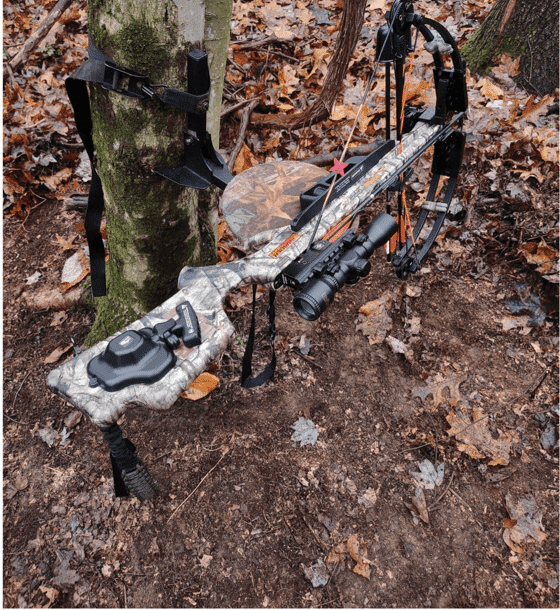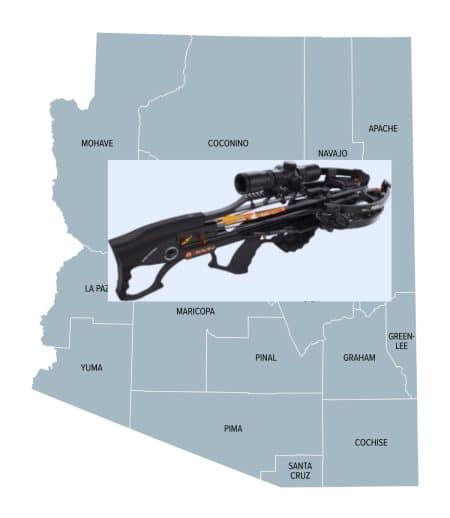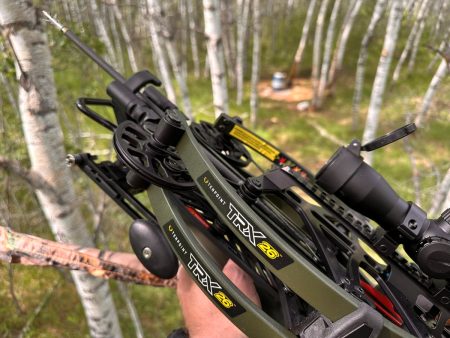Like most deer hunters, I often hunt from a tree stand, but let me pose three questions regarding the use of elevated stands for hunting with a crossbow, or any other weapon. Is waiting for a deer the equivalent of hunting, as defined by Webster’s dictionary? Does shooting a deer with a crossbow from an elevated stand require any more skill than shooting a target in the backyard? My third and perhaps most soul-searching query follows. Is being isolated on an elevated stand the most enjoyable method of hunting?
First and foremost, having the proper crossbow for deer hunting is key – here are our top picks when it comes to a deer hunting crossbow for all budgets.
Below is our list of the best deer hunting crossbows. Click the orange to see why we chose it, and click the green to shop for the item.
-
Best Overall – TenPoint TX440 (Click to Shop)
-
Fastest Crossbow for Deer Hunting – The TenPoint TRX 515 (Click to Shop)
-
Best Value Deer Hunting Crossbow – Barnett Hyper Raptor (Click to Shop)
-
Best Deer Hunting Crossbow for under $500 – Killer Instinct Vital X (Click to Shop)
-
Most Accurate – Ravin R29X (Click to Shop)
Best Overall – TenPoint TX440 (Click to Shop)
The Why:

Performance That Speaks Volumes – With a chronographed speed of 415.8 fps, the TX 440 delivers blistering arrow velocity, even though its advertised speed of 440 fps is among the fastest in its class. The precision is unmatched, with a three-shot group producing arrow shafts touching at 3/8 inches. Moreover, the bow’s tested 0.7 fps variance across three shots highlights its consistent performance—ideal for hunters who demand repeatable accuracy. Its measured quietness was a revelation at the range. It will be appreciated in the deer woods with a decibel average of just 100.9 dB, making it one of the stealthiest options available.
Superior Build and Design – The forward-draw limb configuration and new twin riser design reduce flex, weight, and vibration, resulting in a compact crossbow that’s only 6.5 inches wide cocked and 28 inches long. This compactness enhances maneuverability, whether maneuvering in a tree stand setup or setting up in a ground blind. The innovative floating arrow system, with spring-loaded ball bearings, reduces friction and extends string life, making it a bow designed to last.
Exceptional Features – The TriggerTech Trigger stands out as a masterpiece of engineering. With a 3-pound pull weight and no creep, it delivers a crisp, clean break reminiscent of custom triggers on precision firearms. This makes it easier to focus on the shot and increases confidence in critical hunting situations. The AR-style ambidextrous safety is conveniently placed and very quiet to engage, and the integrated cocking and de-cocking device is the safest and simplest mechanism in its class.
Ready-to-Hunt Package – The TX 440 comes fully equipped with a premium illuminated EVO-X Marksman Elite Scope, quiver, arrows, and field points, offering a complete hunting setup right out of the box. Just add your favorite Broadhead. Our test team praised the scope, which provides sharp clarity and reliable performance, ensuring every shot is on target.
Pros:
- TriggerTech Trigger ensures unparalleled shot control with a clean break.
- Compact and adjustable design fits a variety of shooting situations.
- Quiet operation, ideal for stealthy hunting.
- Minimal shot variance ensures consistent precision.
Cons:
- The premium price may not fit every budget.
- Requires proprietary nocks, limiting compatibility with existing arrows.
The Verdict
The TX 440 set the benchmark at the test range and will not disappoint in the deer woods, excelling in every critical area. Its balance, ease of use, and premium features make it a top choice for any serious hunter or shooter. Whether you’re new to crossbows or a seasoned veteran, this bow’s unmatched performance, innovative design, and complete package deliver unparalleled value. If you’re looking for the crossbow that all others will be judged against, the TX 440 is it.
Fastest Crossbow for Deer Hunting – The TenPoint TRX 515 (Click to Shop)
The Why:
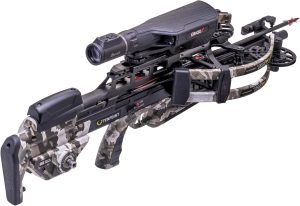
Blazing Speeds for Ethical Shots – With an advertised speed of 515 fps and a chronographed speed of 489 fps, the TRX 515 redefines performance standards in the crossbow world. These speeds ensure flatter trajectories and devastating energy on impact, making it highly effective for long-range shots and ensuring ethical kills in deer hunting scenarios.
Engineered for Accuracy – Despite its incredible speed, the TRX 515 doesn’t compromise on accuracy. With a three-shot group of 1 3/8 inches, it delivers tight arrow groupings that boost confidence in the field. This level of precision is perfect for deer hunting, where shot placement is critical.
Lightweight and Compact Design – At 29 inches long and a mere 6 inches wide when cocked, the TRX 515 is both lightweight and maneuverable, making it ideal for hunters in tree stands or ground blinds. Its reverse-limb design enhances balance, reducing shooter fatigue during long hunting sessions.
Superior Cocking and Safety Mechanisms – The ACUslide MAXX system offers effortless cocking and de-cocking, requiring only 7.2 pounds of pressure, ensuring safety and ease of use. With built-in anti-dry-fire technology and an AR-style ambidextrous thumb safety, it’s designed to prevent mishaps, even in high-stress hunting situations.
Innovative Features – Reverse-Draw Limbs: The longer power stroke generates incredible speed and energy while maintaining a balanced feel.
- Zero-Trac Barrel: Reduces weight, eliminates friction, and increases arrow speed and string longevity.
- TriggerTech Trigger: With zero creep and a crisp break, it delivers unmatched shot control and enhances accuracy.
- Floating Arrow System: A specialized nock locks the arrow in place, while ball bearings on springs float the arrow for smoother, more consistent shots.
Complete Ready-to-Hunt Package – The TRX 515 is a true plug-and-play crossbow, packaged with a premium EVO-X Marksman Elite Scope, quiver, arrows, bubble level, bow hook, and the ACUslide MAXX system. The Marksman Elite Scope provides excellent clarity and precision, designed to match the TRX 515’s performance for hunting in varied lighting and distances.
Pros:
- Unmatched Speed: Among the fastest crossbows available, ensuring greater range and impact.
- Accurate and Consistent: Tight arrow groupings boost confidence for ethical hunting.
- Safe and Easy to Use: Features like the ACUslide MAXX and anti-dry-fire technology enhance safety and usability.
- Compact and Lightweight: Perfect for maneuvering in tight hunting setups.
Cons:
- Premium Price: The high performance comes at a premium, but the quality and features justify the investment.
- Proprietary Arrows: Requires specific nocks, which means replacing or updating your arrow arsenal.
The Verdict
The TRX 515’s speed and accuracy ensure you’ll have the edge when it matters most. Its compact design makes it perfect for tight tree stands or ground blinds, while the quiet operation and safety features give you confidence in the field. This crossbow is engineered to make every shot count, delivering unmatched performance that serious deer hunters will appreciate.
If speed, precision, and innovation top your list, the TRX 515 is the ultimate hunting companion.
Best Value Deer Hunting Crossbow – Barnett Hyper Raptor (Click to Shop)
The Why:
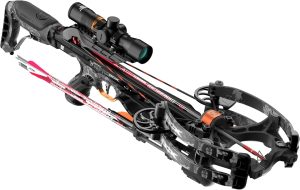
Performance and Speed – The Hyper Raptor propels 400-grain bolts at speeds over 400 fps, delivering ample kinetic energy for ethical deer hunting. This velocity ensures flatter trajectories and effective penetration, which are crucial for successful hunts.
Innovative Design – Barnett’s patented Step-Through Riser integrates the foot stirrup into the riser, resulting in a more compact and balanced crossbow. The self-timing Infinity Cams provide a smoother draw cycle, enhancing accuracy and consistency.
User-Friendly Features – The TriggerTech trigger offers a crisp, clean pull, contributing to precise shot placement. An adjustable, tactical, telescoping butt stock and an adjustable forestock allow for a customized fit, accommodating various shooter preferences.
Ready-to-Hunt Package – The Hyper Raptor comes equipped with a 4×36 illuminated multi-reticle scope, three 20” HyperFlite™ arrows, a sled-style rope cocking device, and a premium side-mount quiver. This comprehensive package ensures hunters are prepared for the field without the need for additional purchases.
Pros:
- High Performance: Achieves speeds up to 430 fps, suitable for deer hunting.
- Innovative Design: Features like the Step-Through Riser and Infinity Cams enhance balance and accuracy.
- User-Friendly: Adjustable stock and quality trigger system cater to shooter comfort and precision.
- Comprehensive Package: Includes essential accessories, offering excellent value.
Cons:
- Proprietary Arrows: Requires specific HyperFlite™ arrows, limiting compatibility with existing arrows.
- Draw Weight: At 205 lbs, it may be challenging for some users without the cocking device.
The Verdict
The Barnett Hyper Raptor delivers exceptional performance and innovative features at an accessible price point, making it an outstanding value for deer hunters seeking reliability and efficiency in the field.
Best Deer Hunting Crossbow for under $500 – Killer Instinct Vital X (Click to Shop)
The Why:
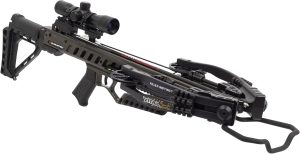
Performance That Packs a Punch – The Killer Instinct Vital X boasts speeds of up to 405 fps, propelling arrows with a kinetic energy of 142 ft-lb. This ensures devastating penetration and stopping power, essential for ethical deer hunting. Its 14.25-inch power stroke and 185-lb draw weight allow it to generate impressive force, rivaling many higher-priced crossbows.
Accuracy and Precision – Accuracy is where the Vital X truly shines. Consistent and tight shot groupings at ranges of 40-50 yards make it a reliable hunting tool. Its enhanced 3.5-lb trigger system ensures a crisp release with minimal creep, contributing to its precision. Paired with the included Lumix 4×32 scope, hunters can expect clear visuals and confidence in every shot.
Ergonomic and User-Friendly Design – Weighing just 7.8 lbs (without the scope and quiver), the Vital X is lightweight and well-balanced, making it ideal for extended hunts. Its adjustable stock ensures a comfortable fit for shooters of all sizes, while the compact dimensions—6.75 inches wide cocked and 10.375 inches wide uncocked—enhance maneuverability in tight spaces like tree stands or blinds.
Safety and Convenience – The anti-dry fire system and ambidextrous safety switch make the Vital X a safe and beginner-friendly choice. These features prevent unintentional discharges and ensure peace of mind in high-pressure hunting situations. Additionally, the straightforward assembly process and included accessories make it easy to get started right out of the box.
Ready-to-Hunt Package – The PRO Package includes:
- 4×32 Lumix Scope for enhanced aiming precision.
- Quiver and three 20-inch HYPR Lite bolts with field tips.
- Rail lube for maintaining performance.
This comprehensive setup ensures hunters are field-ready with minimal additional investment aside from broadheads. Read our Review
Pros
- Affordable Performance: Competitive specs at a budget-friendly price.
- Accurate and Precise: Tight shot groupings with a crisp trigger.
- Compact and Lightweight: Perfect for long hunts and tight hunting setups.
- Complete Package: Includes everything needed to start hunting immediately.
Cons
- Broadhead Not Included: Requires an additional purchase to complete the hunting setup. Select a Broadhead
- Not as Premium: While excellent for the price, it lacks some high-end features of more expensive models.
The Verdict
The Killer Instinct Vital X strikes the perfect balance between price and performance. Its speed, accuracy, and ready-to-hunt package make it an unbeatable option for hunters on a budget. Whether you’re a novice or an experienced deer hunter, this crossbow provides reliability and efficiency without breaking the bank.
If you’re searching for a cost-effective crossbow with all the essential features for a successful hunt, the Killer Instinct Vital X is the clear choice under $500.
Most Accurate – Ravin R29X (Click to Shop)
The Why:
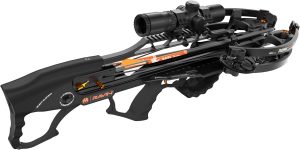
Performance and Power – The Ravin R29X launches bolts at a blistering 450 fps, generating an impressive 180 foot-pounds of energy with a 400-grain arrow. This power ensures deep penetration and flat trajectories, crucial for clean, ethical kills on deer. The combination of speed and energy guarantees exceptional performance at various ranges.
Unmatched Accuracy – What sets the Ravin R29X apart is its Trac-Trigger Firing System, which ensures unparalleled precision. This system moves the trigger mechanism down the rail, perfectly aligning the arrow and string, resulting in exceptional shot consistency. Paired with the 100-yard illuminated 550 fps scope, this crossbow delivers incredible accuracy for long-range shots needed for red stag hunts and whitetail hunts along a field’s edge in the early morning.
Compact and Lightweight Design – At only 6 inches axle-to-axle when cocked and 10.5 inches axle-to-axle when uncocked, the Ravin R29X is one of the most compact crossbows available. Its lightweight design, at just 6.75 pounds, ensures maneuverability and ease of handling, making it perfect for tight hunting setups like tree stands or ground blinds.
User-Friendly Features – The ambidextrous cocking system allows hunters to cock and de-cock the bow with minimal effort, requiring only 12 pounds of draw force. This system also permits stopping and restarting the draw cycle, adding flexibility and safety. The built-in cocking mechanism is silent, ensuring stealth during critical moments in the field.
Other features include:
- HeliCoil Technology: Ensures even cable tension and precise string alignment, contributing to the R29X’s renowned accuracy.
- Anti-Dry Fire and Auto Safety: Provides added safety, preventing accidental discharges.
- Built-In Sling Mounts: Enhance portability during long hunts.
Complete Hunting Package – The Ravin R29X comes fully equipped with:
- Three 400-grain Ravin arrows with .003 straightness for maximum consistency.
- 100-yard illuminated scope optimized for high speeds.
- Removable draw handle for ease of cocking.
- The quiver and mounting bracket are ready for field use.
Pros
- Unparalleled Accuracy: Trac-Trigger Firing System and HeliCoil technology ensure tight shot groupings.
- Compact and Lightweight: Easy to maneuver in tree stands and ground blinds.
- User-Friendly Cocking: Silent, ambidextrous system for seamless cocking and de-cocking.
- Complete Package: Includes all essentials for immediate use.
Cons
- Premium Price: The advanced technology comes at a higher cost.
- Proprietary Arrows: Requires Ravin’s specific bolts, limiting arrow options.
The Verdict
The Ravin R29X redefines precision with its innovative Trac-Trigger and HeliCoil technologies, ensuring every shot lands exactly where it’s aimed. Its compact design, lightweight build, and advanced features make it a top-tier choice for deer hunters who prioritize accuracy above all else. With the ability to shoot with confidence at extended ranges, the Ravin R29X is the ultimate crossbow for those who demand the best in precision and performance.
Now, back to how…
During the 2022 archery season, I decided to get back to the basics of actual hunting. It’s not that I always chose to hunt from a portable stand, but I certainly was in my portable stand for 99% of my archery hunts. Maybe I had a good reason for sitting more from a stand. I hunted with tremendous knee pain during the previous few years. Thankfully, I had the knee replaced in January of 2022, and after defeating some post-op obstacles, my recovery began to speed along. During the summer, I pleasantly discovered I was able to again hike all over the mountains and forests, pain-free for the first time in years. Those hikes were encouraging, and I knew I would be able to cover as much ground as I desired when hunting season arrived.
I rediscovered the freedom experienced by moving about and seeing what was on the other side of the mountain so to speak. I wandered about, locating fresh scrapes, rubs, and deer trails I was previously unaware of on the public lands where I routinely hunt. My portable, elevating tree stand was still used occasionally, but I purposely ignored the tree stand on most occasions and locked it in the bed of my truck. I ignored the lethality provided by hunting from above the animals and chose instead to get back to the basics of hunting in the truest sense of the word. I’ve killed many deer in my life from a portable tree stand during archery seasons, but I preferred to rekindle the fun that accompanies hunting at ground level. That choice meant I might go without tagging an animal during the archery season, but killing a deer didn’t mean as much to me as enjoying the activity itself.
There is little doubt that hunting from a treestand will provide the best opportunity to hang a tag on a whitetail deer. Tree stands take away the deer’s most proficient means of defense by keeping your human scent above the forest floor.
It’s also a fact that deer are less likely to look up, though they do catch me in my elevated perch much more than they did when I first started using a portable stand in the mid-1980s. Hunting from an elevated position is the most proficient way to get a shot because looking d over shrubbery is certainly easier than trying to spot a deer while looking through brush and struggling to find an opening to place a good shot.
It is undeniably more fun to hunt at ground level and move about the habitat freely. I admit that at times I have been guilty of getting so determined to put meat in the freezer that we forget the most important benefits of hunting.

Gaining knowledge is a gift. We are never too old or too experienced to learn more about the areas where we hunt. That is especially true for those of us who do not enjoy the luxury of hunting private land.
For example, how much time do you take to fully analyze what a deer rub reveals? I have met dozens of hunters who falsely believe small bucks rub small-diameter trees and large bucks rub larger-diameter trees. That is in fact poppycock! I state that with supreme confidence because I have photographed spike bucks rubbing a tree that a buck with a 20-inch inside spread could never fit between its antlers.
I was advised by an old-timer to take time and examine rubs more carefully. His advice has proven wise. If you want to determine whether a big buck creates a rub, examine any brush or other small trees growing behind the primary rubs on smaller-diameter trees. If there are incidentally damaged branches or limbs behind the primary rub, it is irrefutable evidence that a large buck was rubbing that tree. You can perform all the preseason scouting you want but much of the rubbing continues to occur well into most archery seasons. If you are stuck in a tree stand during every hunt, you are not going to witness the most recent rubbing activity.
Mating scrapes become more prevalent as the rut heats up. If you are free to move around, dominant scrape lines become more apparent, which, of course, provides information that could indicate several great areas to ambush a quality buck, whether from the ground or simply finding a better place to hang a tree stand. It is rewarding to locate a line of scrapes while still hunting.
Once upon a time, it was considered worthwhile to understand how to read a deer’s track. Pity that seems to be an art that is waning and being replaced by trail camera technology. I love reading tracks as my father taught me in the 1960s. When I see deer tracks, I hear my late father’s voice. “Was the imprint made by a buck or a doe? Does the track reveal a large animal or a mediocre deer? Are the tracks revealing if deer only use a particular trail to travel only in one direction?” I’m happy when I remember his lessons. If you are only hunting for a large buck and trying to determine the best spot in an environment that will grant the best chance of encountering that animal, its tracks in the earth may provide valuable information. Again, I remind you that I hunt deer almost exclusively on land that is open to the public.
What are the animals eating? Acorns that may not have fallen during the preseason may litter the forest as the season progresses. Are crab apple trees available and are they being visited by the animals? Are deer moving along specific trails that lead to fields of corn or other crops? Moving through the woods will reveal such information.
What exactly is this action known as still-hunting? Some people are confused, and justifiably so. I mean, what the heck? The word still literally means to be motionless. I have no idea how it came to be known as still hunting, but as near as I’ve ever understood it, the term was adapted because the hunter moves so slowly and stops so often that the hunter’s movements are imperceivable to the animals.
If you know anything about deer and most big game animals for that matter, their eyesight leaves a bit to be desired. However, they quickly spot motion, especially anything moving out of concert with other items in their environment. For example, we humans tend to waddle a bit as we move, and even if we don’t, as we walk, turn, or commit any action within sight of a deer, it is not going to be a waving motion of branches or brush waving because of wind. They instantly catch the difference in movement direction and instantly perceive odd movements as revelations of something possibly dangerous.
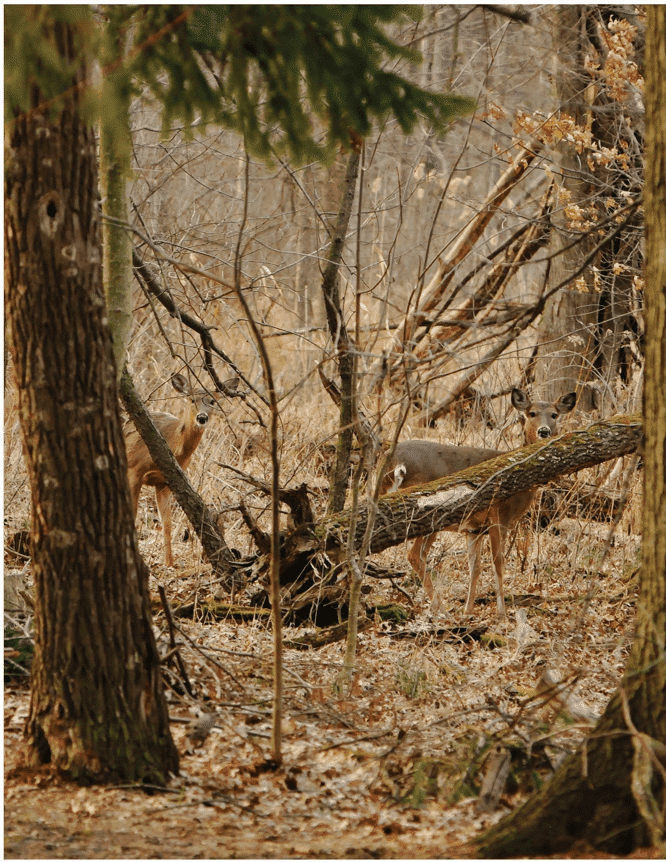
Still Hunting
If the trick is to appear motionless, how in the world do we achieve such a goal? The legendary bowhunter Fred Bear described still hunting in this manner. “Move like a deer moves”, advised Bear. “Unless deer are fleeing danger, or in the throngs of mating season, deer teach us how to move”, he explained. “A relaxed deer seldom takes more than a dozen steps without stopping and surveying the area for danger.” Often, they move just a few steps, feed a moment, look about, and then smoothly move just a few more steps before stopping again. Mr. Bear advised taking no more than three to five, purposely small steps, before stopping for at least a full minute to search with eyes attached to a slowly swiveling head, and never forgetting to look behind. To get a shot at a deer, it is nearly always necessary for the hunter to see the animal before the animal notices the hunter.
If you’ve never still hunted on the rough ground of a forest in such a disciplined manner, do not be lulled into thinking it’s a very simple process. I guarantee that if you travel only half of a mile hunting in such a manner, you will be amazed at how strenuous it is for a human’s lower back and leg muscles, which are not accustomed to having muscles held in strenuous positions for long periods. Our muscles and tendons contort to many positions as we walk normally, but they are seldom held in the same stretched position for a full minute. When we purposely move at a snail’s pace for only a few steps and stop again we experience ever-changing stresses because we are accessing uneven ground. Even on relatively level ground, our feet experience prolonged standing at constantly changing angles. A few degrees uphill this time, a few degrees downhill the next time we halt for a full minute or more, and maybe canted left or right the next time we stop. Among the best pieces of advice I have ever received regarding hunting at ground level is the need to stop for four to five minutes after snapping a branch that was buried beneath fallen leaves or under tall grass. A tree could blow down, and a deer will barely pay attention to it, but the head of a deer that was feeding on ground-level food sources, such as acorns or mushrooms, will snap instantly up and to attention the instant it hears a broken branch at ground level. Their sight might not be the best, but those large ears gather and decipher sounds incredibly well. Especially sounds that indicate danger might be lurking nearby. The jig is up if you take even one more step when they are alerted and anticipating danger.
When you choose to hunt at ground level you forfeit the benefit of having your scent drifting above deer that are within a hundred yards. Since it is necessary to at least close the distance to 40 yards or less to reliably place a lethal shot from our crossbows, what can we do? This is when the hunter must come to grips with the handicap and learn the enhanced skill of using the wind to his or her advantage.
Moving directly into the wind is one way of doing so. It is highly unlikely a mature deer will come toward the hunter if the animal is downwind. It’s unlikely the hunter will even see that animal. Therefore, being downwind appears to be the most desirable position. Not so fast! Deer are born with an instinct to stay alive, and just as humans accept their weaknesses and adapt, so do the animals. Because they know they cannot smell predators approaching from downwind positions, and they have also learned that the sounds that betray predators are also carried downwind, deer develop a habit of looking downwind more often than in any other direction. They try as hard as they can to make up for their vulnerability with their eyes.
Therefore, I will once again share advice from the late, great Fred Bear. When being interviewed by famed outdoor communicator, Curt Gowdy, Fred advised hunting with a crosswind. “As you look forward, it is best if a breeze hits squarely against one cheek or the other.” Assuming you are doing all the other things correctly, this will give you the best chance of going unnoticed before you are in shooting range. Of course, there are no guarantees in any hunting circumstance. The best any hunter can do is to nudge the odds as much as possible in his or her favor.
Spot and Stalk Hunting
While I believe still hunting is the most interesting form of hunting with any weapon, it is not the only method available to ground hunters. Spot and stalk is an interesting way to hunt for game animals, though it is not as practical for hunting in whitetail country as it is out west for pronghorns or mule deer where long shots are taken with rifles. It’s less practiced in the east even by rifle hunters, though they would be satisfied with getting to within 150 yards or so. Still, there are areas where it is possible to walk slowly along elevated terrain, or from other vantage points to spy bedding or feeding whitetail deer. Then the crossbow hunter could try to sneak within crossbow range. It’s a tall order, and not recommended for the crossbow hunter who will be emotionally destroyed by failure because they will bomb nearly every time.
It happens that I live near public land that includes slightly elevated ridges allowing me to gaze into a bowl-shaped, low terrain with a habitat that consists of 60% thorns and thickets. It is about 160 yards across the low area to the opposite bank, and some openings allow me to see as far as 60 yards. Obstacles are many, and to avoid bolt deflection, a shot of 40 yards or less is desirable in most of this area. Here and there I can spot the opposite ridge, but those spots are rare. If I happen to notice a deer moving through the thicket at the center of the bowl or closer to the opposite side of the low area, I have the option of sneaking along the ridge in hopes of getting ahead of the animal. I may then move into the gully through one of the openings and hope to ambush the animal if it passes nearby. Frankly, I have tried that a few times with my crossbow and I have never been successful, but the anticipation of outwitting the animals does at least get the blood flowing.
Hunting at ground level does not mean walking through the woods all day without rest. Young hunters can probably stand near strategically placed trees for hours. I remember those days, but I’ve been hunting deer for 55 years, and those days are long in my past. I can only tolerate standing still in one place for 30 minutes or so. Thankfully, several manufacturers sell portable seats. A hunter can bring one of those lightweight foam pads that allow comfortable seating on stumps or blowdowns. Perhaps it’s just me, but I never feel those stumps and horizontal trees are where I want to sit. Therefore, I usually choose instead one of the portable tree seats that can be slung over a shoulder and conveniently carried throughout the woods. When desired, it will hang on a tree’s trunk by virtue of a nylon strap. The most fun I have while hunting deer occurs when I combine hunting methods throughout the day. A favorite combination, which can vary per every hunter’s whim, is to be seated next to a strategic tree during the first hour or two of light. I then still hunt for an hour or so, before sitting again for about 30 minutes. I alternate slowly moving and sitting throughout most of the day, but I make certain I’m sitting near a large tree to enjoy the last 90 minutes before dark. If I want to hunt from above, I can always go back to my truck shortly after lunch to retrieve my tree stand; carry it in, and hunt from it until quitting time. Often, some of the things I learned while moving earlier in the day will help me choose the optimum tree to climb and wait.
A few safety items are worth considering. First and foremost, do not rely only on the trigger safety if you are going to move about the forest floor with a crossbow, and never allow a hand to grasp the rail while the string is cocked. Every crossbow I have ever seen includes an anti-dry fire, safety latch. I would not recommend walking with a cocked crossbow that does not include this feature. An arrow can be mounted on the rail and held in- place by the arrow retention spring, but still, be positioned forward enough that the safety latch is engaged. This will make it virtually impossible to accidentally release the string, even if the trigger safety somehow fails. When a game animal is spotted, the arrow can be moved back inches so the crossbow can fire. In my home state of Pennsylvania, crossbow seasons overlap with some firearm seasons. Consequently, I wear orange when I’m on the ground and moving. Deer do not see color anyway. Use natural structures to break up the human silhouette.
Always respect the broadhead. When walking with an arrow on the rail, be certain to hold the crossbow slightly canted downward and well in front of your body. Be prepared to keep the arrow away from your body should a slip or trip be encountered. This is yet more motivation to move carefully and extremely slowly.
I advise ingesting potassium and staying hydrated throughout the day. Walking on the uneven forest floor puts different stresses on leg muscles than experienced on flat surfaces. After a full day of still hunting, I keep a glass of water and over-the-counter leg cramp meds on the bedstand. These items help me avoid crippling hamstring cramps that invariably occur in the middle of the night.
Every hunter must determine what aspects of hunting are most important to them. Do not continue hunting if the vision of fleeing deer haunts your dreams. Hunting is a challenge, and you will lose more often than you will experience success, but for some of us, the act and the challenge are worth the price.
Success is possible, though. I harvested a medium-sized, antlerless deer from ground level with my crossbow, and I felt I had accomplished something just a little more satisfying than shooting a deer from an elevated stand. If you are up for a challenge, consider hunting at ground level. The experience will bring you back to the roots of our beloved activity.
Happy trails and may gentle breezes favor your position.
Per our affiliate disclosure, we may earn revenue from the products available on this page. To learn more about how we test gear, click here.

